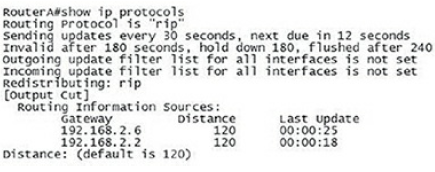- Home
- Networking
- CCNA Routing and Switching 200-125
51.
Which command will allow you to see the path on which a packet gets routed to
its destination?
- A.Router#show ip route
- B.Router#tracert 192.168.7.56
- C.Router#pathping 192.168.7.56
- D.Router#traceroute 192.168.7.56
- Answer & Explanation
- Report
Answer : [D]
Explanation :
Explanation :
| The command traceroute will allow you to verify the path on which a packet gets routed. |
52.
Which command will allow you to check basic connectivity at layer 3?
- A.Router#show ip route
- B.Router#ping 192.168.4.1
- C.Router#pathping 192.168.4.1
- D.Router#ip ping 192.168.4.1
- Answer & Explanation
- Report
Answer : [B]
Explanation :
Explanation :
| The ping command will allow basic connectivity testing at layer 3. |
53.
In the following exhibit, when will a route be removed from the routing table for
RIPv2?

- A.30 seconds
- B.180 seconds
- C.360 seconds
- D.240 seconds
- Answer & Explanation
- Report
Answer : [D]
Explanation :
Explanation :
| The route will be flushed from the routing table after 240 seconds. The flush timer should be 60 seconds higher than the invalid timer of 180 seconds. |
54.
How would you configure a router to use split horizons for RIPv2?
- A.Router(config)#ip rip split-horizon
- B.Router(config-if)#ip split-horizon
- C.Router(config-router)#ip split-horizon
- D.Router(config-router)#rip split-horizon
- Answer & Explanation
- Report
Answer : [B]
Explanation :
Explanation :
| The command ip spilt-horizon configured on the interface will configure split-horizon processing for RIPv2. |
55.
Which command will display which routes the RIPv2 router is advertising?
- A.Router#show ip route
- B.Router#show ip rip database
- C.Router#show ip rip
- D.Router#show ip interface
- Answer & Explanation
- Report
Answer : [B]
Explanation :
Explanation :
| The command show ip rip database will display the routes being advertised by RIPv2. These routes will be identified with the directly connected statement. |